Fast and Furious Delivery: What is Precipitous Labor?

Labor and delivery can be emotionally and physically challenging for many women. Many women may hope for quick and easy delivery, but for some people, labor goes much faster than expected.
A too-fast delivery—precipitous labor—may even be dangerous.
What is precipitous labor?
The typical labor and delivery last roughly 12 to 19 hours for first-time mothers and around 14 hours for second-time moms, according to the March of Dimes.
While many women would prefer labor with little medical intervention, fast labor has its risks.
"A precipitous delivery is when someone delivers their baby fast," said Jessica Auffant, M.D., an OB-GYN at Orlando Health Physician Associates. "Usually it is defined as delivering their baby within three hours of the start of painful regular contractions until delivery."
What causes precipitous labor?
"I don't think we know why it happens," said P. Fadwah Halaby, a Florida-based nurse practitioner and certified nurse midwife and founder of Midwife360.
Some women may labor for only 45 minutes with one baby, then experience a six-hour labor with the next birth.
Halaby said one possible reason for short labor is the woman could be unaware she’s in labor until the very end.
"People who have had previous vaginal births are more likely to experience precipitous labor than those who are birthing for the first time," Halaby added. "Those who have experienced preterm labor and birth, as well as previous precipitous labors, are also more likely to experience this."
Anyone can experience precipitous labor, but certain factors can increase the risk, according to the American Pregnancy Association and a 2004 study. These risk factors include:
- Fertility treatments
- Chronic hypertension
- A uterus that contracts exceptionally well
- Accommodating birth canal
- Previous rapid labor
- Placental abruption
- Intrauterine growth restriction
- Induction with prostaglandins (stimulate the onset of labor)
- Low birth weight
What are the signs of precipitous labor?
Precipitous labor begins so suddenly that you may not have enough warning. Some women may feel contractions starting one after the other or as an endless contraction or pressure and an urge to push. During rapid labor, some people are unaware they are in active labor until the very last moment when it becomes painful. That’s an expected occurrence.
With precipitous labor, there may be very little pain, or the pain may rapidly increase, said Auffant.
"There may be some discomfort that is not recognizable as labor because there's no clear start and stop to the sensations, and then all of a sudden, there are clear contractions as the person gets closer to complete dilation," Halaby said. "Early signs may be that the cervix is very ripe and favorable for birth, completely effaced, and already dilated several centimeters."
What are the complications of precipitous labor?
There are many factors that can influence labor time, many of which are unavoidable.
The first stage of labor is the longest. As the contractions begin, your cervix will soften and gradually start to open. This gives most women enough time to prepare for the birth and make any necessary arrangements.
Once your cervix dilates to around 6 centimeters, you are in established labor. When you begin to experience one-minute contractions five minutes apart over the course of an hour, it’s time to go to the hospital or call your midwife.
However, precipitous labor skips many stages of labor, which can put you at greater risk of complications. Living quite far from a hospital or being unaware you are in active labor until the last moment may create a higher chance you give birth in a car or somewhere outside of a hospital.
Auffant said this situation could put the mother and the baby at risk. Maternal complications such as bleeding or lacerations from birth require immediate medical attention.
A woman who experiences precipitous labor is more likely to tear during birth since the cervix doesn’t have time to gradually soften and open. Additionally, there will be no access to pain management, such as an epidural, which may add to the mother’s stress.
Giving birth outside of a hospital can lead to a potentially dangerous scenario if the baby is in distress or requires resuscitation. Get medical attention as soon as possible.
It's normal for mothers to struggle with the emotions of precipitous labor. They could experience feelings of shock, regret at a birth that didn’t fit their mental image, or depression.
What should you do if you’re experiencing precipitous labor?
Any woman in precipitous labor needs immediate help. If you are planning to give birth at home or a birthing center, call your healthcare provider. For hospital births, Hallaby recommends you call 911 as soon as you are aware you’re in established labor. It could save a life—yours or your baby's.
"Paramedics are trained to deliver babies and can assist, and if it is so rapid that they cannot, 911 personnel are also trained and able to assist with deliveries," Auffant said, adding they can help you and your baby have the best possible outcome.
If delivery occurs prior to reaching a hospital, Auffant has some tips:
- Keep the baby skin to skin for warmth.
- Dry the baby with towels or clothing.
- Leave the umbilical cord attached if possible.
- Reach a medical facility for evaluation of mom and baby as soon as possible.
Can you avoid precipitous labor?
There is often nothing you can do to avoid precipitous labor. Every birth is different, so there is no telling whether you will have fast labor. If you have experienced precipitous labor in the past, that does not necessarily mean that you will experience it with the next birth.
However, Auffant said women with a history of precipitous labor are sometimes scheduled for elective inductions at 39 weeks to avoid this experience in the future. Speak with your doctor if you have questions on how to prevent preterm birth and if you worry about your chance of having another rapid labor.
The bottom line
Rapid labor and delivery sounds appealing, but it can be harmful to the mother. Know the signs of precipitous labor so you can get help fast. If you’ve experienced precipitous labor already, discuss a birth plan with your doctor to best prepare for a home or hospital birth.


















